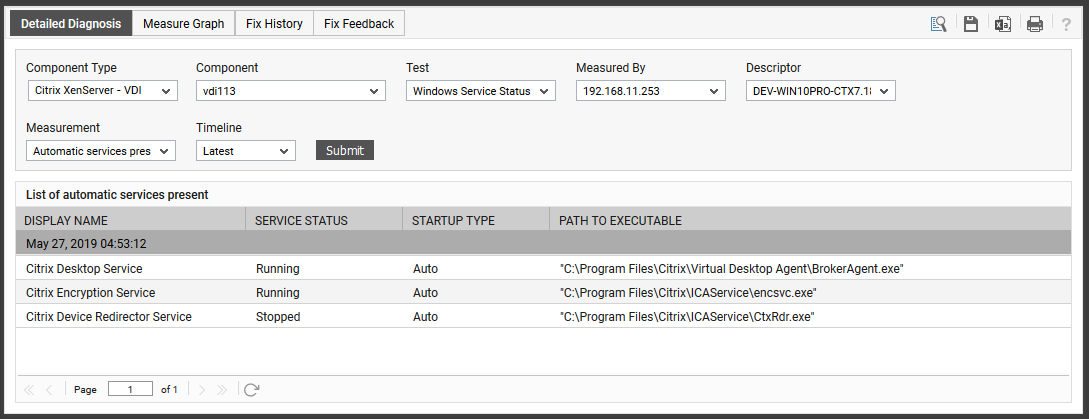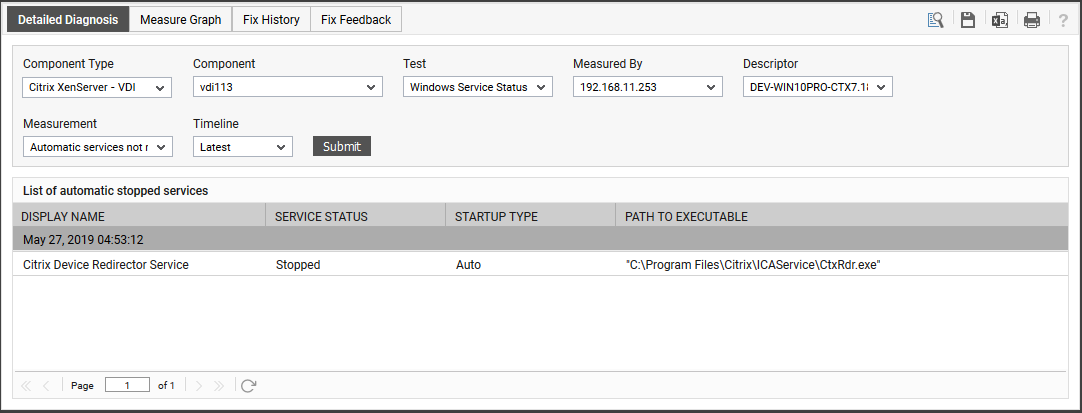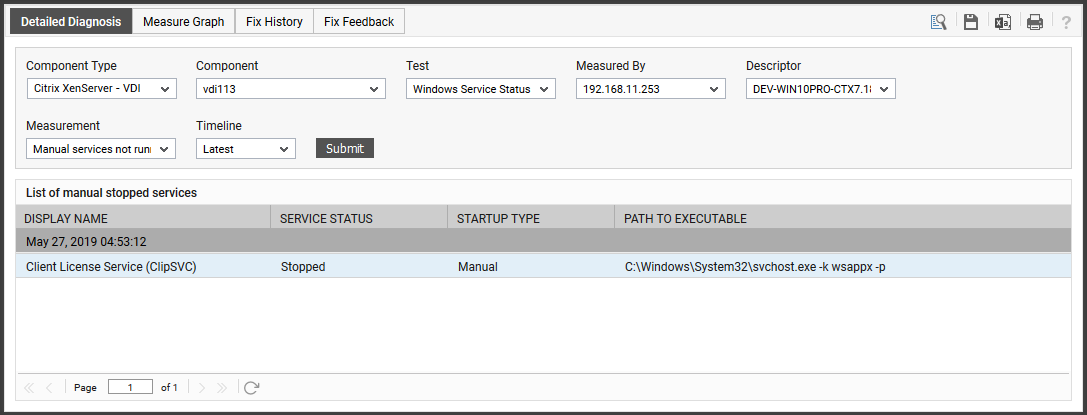Windows Service Status - OS Test
In some virtual environments, administrators may want to mandate the availability of a set of Windows services on all Windows virtual desktops. In such environments, to ensure uninterrupted access to the mandatory services, administrators need to check the availability of the services on every virtual desktop. To cater to this need, this test allows administrators to configure only the mandatory services of their choice for monitoring. This way, administrators can closely monitor the availability of the services of their interest and instantly know the number of services that are not available/running (if available) on the Windows virtual desktop.
This test does not only reveal the availability of services, that have been configured for monitoring, on each virtual desktop but also reports the count of available services based on their startup types. This helps administrators to know if the automatic services have started and are running on the virtual desktop as configured. If not, administrators can rapidly initiate the remedial measures to start the services quickly before it impacts overall performance of the virtual desktop and the user experience on the virtual desktop. Furthermore, administrators can use the detailed diagnosis provided by this test to know the details of the configured services that are present and inactive on each Windows virtual desktop.
This test is disabled by default. To enable the test, go to the enable / disable tests page using the menu sequence : Agents -> Tests -> Enable/Disable, pick the desired Component type, set Performance as the Test type, choose the test from the disabled tests list, and click on the < button to move the test to the ENABLED TESTS list. Finally, click the Update button.
Target of the test : A Citrix Hypervisor/ Citrix Hypervisor VDI
Agent executing the test : An internal agent
Output of the test : one set of results will be reported for every Windows virtual desktop on the Citrix Hypervisor/ Citrix Hypervisor VDI server.
| Parameter | Description |
|---|---|
|
Test period |
How often should the test be executed. |
|
Host |
The host for which the test is to be configured. |
| Port |
The port at which the specified host listens. By default, this is NULL. |
|
Xen User, Xen Password and Confirm Password |
To enable the eG agent to connect to the XenServer API for collecting statistics of interest, this test should login to the target hypervisor as a root user. Provide the name of the root user in the Xen User text box. Root user privileges are mandatory when monitoring a XenServer 5.5 (or below). However, if you are monitoring XenServer 5.6 (or above) and you prefer not to expose the credentials of the root user, then, you have the option of configuring a user with pool-admin privileges as the Xen User. If you do not want to expose the credentials of a root/pool-admin user, then you can configure the tests with the credentials of a Xen User with Read-only privileges to the XenServer. However, if this is done, then the Xen Uptime test will not run, and the Xen CPU and Xen Memory tests will not be able to report metrics for the control domain descriptor. To avoid such an outcome, do the following before attempting to configure the eG tests with a Xen User who has Read-only privileges to the Citrix Hypervisor:
Once this is done, you can configure the eG tests with the credentials of a Xen User with Read-only privileges. The password of the specified Xen User needs to be mentioned in the Xen Password text box. Then, confirm the Xen Password by retyping it in the Confirm Password text box. |
| SSL |
By default, the Citrix Hypervisor is not SSL-enabled. This indicates that by default, the eG agent communicates with the target hypervisor using HTTP. Accordingly, the SSL flag is set to No by default. If you configure the target hypervisor to use SSL, then make sure that the SSL flag is set to Yes, so that the eG agent communicates with the target hypervisor using HTTPS. Note that a default SSL certificate comes bundled with every Citrix Hypervisor installation. If you want the eG agent to use this default certificate for communicating with an SSL-enabled Citrix Hypervisor, then no additional configuration is required. However, if you do not want to use the default certificate, then you can generate a self-signed certificate for use by the target hypervisor. In such a case, you need to explicitly follow the broad steps given below to enable the eG agent to communicate with the target hypervisor via HTTPS:
For a detailed discussion on each of these steps, refer to the Troubleshooting section of this document. |
|
Inside View Using |
By default, this test obtains the “inside view” of VMs using the eG VM Agent. Accordingly, the Inside view using flag is set to eG VM Agent by default. The eG VM Agent is a piece of software, which should be installed on every VM on a hypervisor. Every time the eG agent runs this test, it uses the eG VM Agent to pull relevant 'inside view' metrics from each VM. Once the metrics are collected, the eG agent then communicates with each VM agent and pulls these metrics, without requiring administrator privileges. Refer to Configuring the Remote Agent to Obtain the Inside View of VMs for more details on the eG VM Agent. |
|
Domain, Admin User, and Admin Password, and Confirm Password |
By default, these parameters are set to none. This is because, by default, the eG agent collects 'inside view' metrics using the eG VM agent on each VM. Domain administrator privileges need not be granted to the eG agent if it uses this default approach to obtain the 'inside view' of Windows VMs. |
|
Ignore VMs Inside View |
Administrators of some high security XenServer environments might not have permissions to internally monitor one/more VMs. The eG agent can be configured to not obtain the 'inside view' of such ‘inaccessible’ VMs using the IGNORE VMS INSIDE VIEW parameter. Against this parameter, you can provide a comma-separated list of VM names, or VM name patterns, for which the inside view need not be obtained. For instance, your IGNORE VMS INSIDE VIEW specification can be: *xp,*lin*,win*,vista. Here, the * (asterisk) is used to denote leading and trailing spaces (as the case may be). By default, this parameter is set to none indicating that the eG agent obtains the inside view of all VMs on a Citrix Hypervisor host by default. Note: While performing VM discovery, the eG agent will not discover the operating system of the VMs configured in the IGNORE VMS INSIDE VIEW text box. |
|
Exclude VMs |
Administrators of some virtualized environments may not want to monitor some of their less-critical VMs - for instance, VM templates - both from 'outside' and from 'inside'. The eG agent in this case can be configured to completely exclude such VMs from its monitoring purview. To achieve this, provide a comma-separated list of VMs to be excluded from monitoring in the EXCLUDE VMS text box. Instead of VMs, VM name patterns can also be provided here in a comma-separated list. For example, your EXCLUDE VMS specification can be: *xp,*lin*,win*,vista. Here, the * (asterisk) is used to denote leading and trailing spaces (as the case may be). By default, this parameter is set to none indicating that the eG agent obtains the inside and outside views of all VMs on a virtual host by default. By providing a comma-separated list of VMs/VM name patterns in the EXCLUDE VMS text box, you can make sure the eG agent stops collecting 'inside' and 'outside' view metrics for a configured set of VMs. |
|
Ignore Winnt |
By default, the eG agent does not support the inside view for VMs executing on Windows NT operating systems. Accordingly, the IGNORE WINNT flag is set to Yes by default. |
|
Webport |
By default, in most virtualized environments, the target hypervisor listens on port 80 (if not SSL-enabled) or on port 443 (if SSL-enabled). This implies that while monitoring an SSL-enabled Citrix hypervisor, the eG agent, by default, connects to port 443 of the server to pull out metrics, and while monitoring a non-SSL-enabled Citrix hypervisor, the eG agent connects to port 80. Accordingly, the webport parameter is set to 80 or 443 depending upon the status of the ssl flag. In some environments however, the default ports 80 or 443 might not apply. In such a case, against the webport parameter, you can specify the exact port at which the target hypervisor in your environment listens so that the eG agent communicates with that port. |
|
Report by User |
While monitoring a Citrix hypervisor, the REPORT BY USER flag is set to No by default, indicating that by default, the guest operating systems on the target hypervisor are identified using the host name specified in the operating system. On the other hand, while monitoring a Citrix hypervisor-VDI, this flag is set to Yes by default; this implies that in case of the Citrix hypervisor-VDI model, by default, the desktops will be identified using the login of the user who is accessing them. In other words, in VDI environments, this test will, by default, report measures for every username_on_virtualmachinename. |
|
Report Powered OS |
This flag becomes relevant only if the report by user flag is set to ‘Yes’. If the report powered os flag is set to Yes (which is the default setting), then this test will report measures for even those VMs that do not have any users logged in currently. Such guests will be identified by their virtualmachine name and not by the username_on_virtualmachinename. On the other hand, if the report powered os flag is set to No, then this test will not report measures for those VMs to which no users are logged in currently. |
|
Services |
Provide a comma-separated list of services that need to be monitored by this test. When configuring a service name to exclude, make sure that you specify the Display Name of the service, and not the service Name you see in the Services window on your Windows virtual desktop. For example, Citrix Desktop Service,Citrix Encryption Service,Citrix Device Redirector Service,Client License Service (ClipSVC) |
|
DD Frequency |
Refers to the frequency with which detailed diagnosis measures are to be generated for this test. The default is 1:1. This indicates that, by default, detailed measures will be generated every time this test runs, and also every time the test detects a problem. You can modify this frequency, if you so desire. Also, if you intend to disable the detailed diagnosis capability for this test, you can do so by specifying none against DD FREQUENCY. |
|
Detailed Diagnosis |
|
| Measurement | Description | Measurement Unit | Interpretation |
|---|---|---|---|
|
Services configured |
Indicates the total number of services that have been configured for monitoring against the Services parameter. |
Number |
|
|
Services present |
Indicates how many services that have been configured for monitoring are actually present on this Windows virtual desktop. |
Number |
|
|
Automatic services present |
Indicates how many services, with startup type as automatic, that have been configured for monitoring are actually present on this virtual desktop. |
Number |
The detailed diagnosis of this measure lists the services (with startup type as automatic) that are currently present on the virtual desktop. |
|
Automatic services not running |
Indicates how many services, with startup type as automatic, that have been configured for monitoring are not running on this Windows virtual desktop. |
Number |
Use the detailed diagnosis of this measure to determine which services (with startup type as automatic) are not currently running on the virtual desktop. |
|
Manual services present |
Indicates how many services, with startup type as manual, that have been configured for monitoring are actually present on this Windows virtual desktop. |
Number |
The detailed diagnosis of this measure lists the services (with startup type as manual) that are currently present on the virtual desktop. |
|
Manual services not running |
Indicates how many services, with startup type as manual, that have been configured for monitoring are not running on this Windows virtual desktop. |
Number |
Use the detailed diagnosis of this measure to determine which services (with startup type as manual) are not currently running on the virtual desktop. |
|
Total services not running |
Indicates the total number of Windows services, that have been configured for monitoring, are not currently running on this Windows virtual desktop. |
Number |
This measure is the sum of Automatic services not running and Manual services not running measures. |
The detailed diagnosis of the Automatic services present measure lists the display name, current status and startup type of the services, and the complete path to the executable that controls the services.

Figure 1 : The detailed diagnosis of the Automatic services present measure
The detailed diagnosis of the Automatic services not running measure lists the display name, current status and startup type of the services, and the complete path to the executable that controls the services.

Figure 2 : The detailed diagnosis of the Automatic services not running measure
The detailed diagnosis of the Manual services present measure lists the display name, current status and startup type of the services, and the complete path to the executable that controls the services.

Figure 3 : The detailed diagnosis of the Manual services present measure
The detailed diagnosis of the Manual services not running measure lists the display name, current status and startup type of the services, and the complete path to the executable that controls the services.

Figure 4 : The detailed diagnosis of the Manual services not running measure